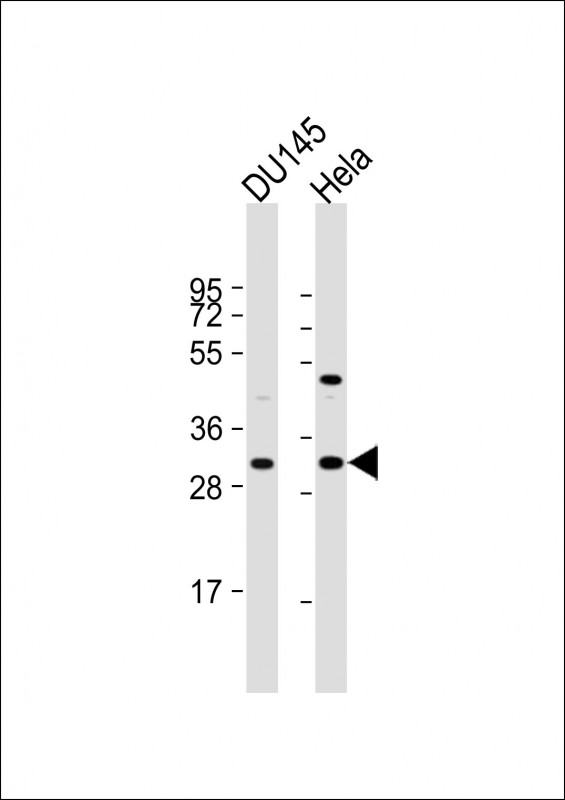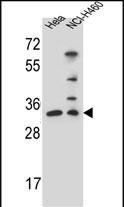NTHL1 Antibody (Center R103)
Affinity Purified Rabbit Polyclonal Antibody (Pab)
- 产品详情
- 实验流程
- 背景知识
Application
| WB, E |
|---|---|
| Primary Accession | P78549 |
| Other Accession | NP_002519.1 |
| Reactivity | Human |
| Host | Rabbit |
| Clonality | Polyclonal |
| Isotype | Rabbit IgG |
| Calculated MW | 33570 Da |
| Antigen Region | 88-117 aa |
| Gene ID | 4913 |
|---|---|
| Other Names | Endonuclease III-like protein 1 {ECO:0000255|HAMAP-Rule:MF_03183}, hNTH1, 322- {ECO:0000255|HAMAP-Rule:MF_03183}, 429918 {ECO:0000255|HAMAP-Rule:MF_03183}, Bifunctional DNA N-glycoslyase/DNA-(apurinic or apyrimidinic site) lyase {ECO:0000255|HAMAP-Rule:MF_03183}, DNA glycoslyase/AP lyase {ECO:0000255|HAMAP-Rule:MF_03183}, NTHL1 {ECO:0000255|HAMAP-Rule:MF_03183}, NTH1, OCTS3 |
| Target/Specificity | This NTHL1 antibody is generated from rabbits immunized with a KLH conjugated synthetic peptide between 88-117 amino acids from the Central region of human NTHL1. |
| Dilution | WB~~1:1000 E~~Use at an assay dependent concentration. |
| Format | Purified polyclonal antibody supplied in PBS with 0.09% (W/V) sodium azide. This antibody is purified through a protein A column, followed by peptide affinity purification. |
| Storage | Maintain refrigerated at 2-8°C for up to 2 weeks. For long term storage store at -20°C in small aliquots to prevent freeze-thaw cycles. |
| Precautions | NTHL1 Antibody (Center R103) is for research use only and not for use in diagnostic or therapeutic procedures. |
| Name | NTHL1 {ECO:0000255|HAMAP-Rule:MF_03183} |
|---|---|
| Synonyms | NTH1, OCTS3 |
| Function | Bifunctional DNA N-glycosylase with associated apurinic/apyrimidinic (AP) lyase function that catalyzes the first step in base excision repair (BER), the primary repair pathway for the repair of oxidative DNA damage (PubMed:29610152, PubMed:9927729). The DNA N-glycosylase activity releases the damaged DNA base from DNA by cleaving the N-glycosidic bond, leaving an AP site. The AP-lyase activity cleaves the phosphodiester bond 3' to the AP site by a beta- elimination. Primarily recognizes and repairs oxidative base damage of pyrimidines. Also has 8-oxo-7,8-dihydroguanine (8-oxoG) DNA glycosylase activity. Acts preferentially on DNA damage opposite guanine residues in DNA. Is able to process lesions in nucleosomes without requiring or inducing nucleosome disruption. |
| Cellular Location | Nucleus {ECO:0000255|HAMAP-Rule:MF_03183, ECO:0000269|PubMed:10882850, ECO:0000269|PubMed:12531031, ECO:0000269|PubMed:9611236}. Mitochondrion {ECO:0000255|HAMAP- Rule:MF_03183, ECO:0000269|PubMed:9611236} |
| Tissue Location | Widely expressed with highest levels in heart and lowest levels in lung and liver. |
For Research Use Only. Not For Use In Diagnostic Procedures.
Provided below are standard protocols that you may find useful for product applications.
BACKGROUND
The protein encoded by this gene is a DNA N-glycosylase of the endonuclease III family. Like a similar protein in E. coli, the encoded protein has DNA glycosylase activity on DNA substrates containing oxidized pyrimidine residues and has apurinic/apyrimidinic lyase activity.
REFERENCES
Wang, W., et al. Nucleic Acids Res. (2010) In press :
Arora, M., et al. Leukemia 24(8):1470-1475(2010)
Thyagarajan, B., et al. Biol. Blood Marrow Transplant. 16(8):1084-1089(2010)
Briggs, F.B., et al. Am. J. Epidemiol. 172(2):217-224(2010)
Goto, M., et al. Carcinogenesis 30(8):1345-1352(2009)
终于等到您。ABCEPTA(百远生物)抗体产品。
点击下方“我要评价 ”按钮提交您的反馈信息,您的反馈和评价是我们最宝贵的财富之一,
我们将在1-3个工作日内处理您的反馈信息。
如有疑问,联系:0512-88856768 tech-china@abcepta.com.























 癌症的基本特征包括细胞增殖、血管生成、迁移、凋亡逃避机制和细胞永生等。找到癌症发生过程中这些通路的关键标记物和对应的抗体用于检测至关重要。
癌症的基本特征包括细胞增殖、血管生成、迁移、凋亡逃避机制和细胞永生等。找到癌症发生过程中这些通路的关键标记物和对应的抗体用于检测至关重要。 为您推荐一个泛素化位点预测神器——泛素化分析工具,可以为您的蛋白的泛素化位点作出预测和评分。
为您推荐一个泛素化位点预测神器——泛素化分析工具,可以为您的蛋白的泛素化位点作出预测和评分。 细胞自噬受体图形绘图工具为你的蛋白的细胞受体结合位点作出预测和评分,识别结合到自噬通路中的蛋白是非常重要的,便于让我们理解自噬在正常生理、病理过程中的作用,如发育、细胞分化、神经退化性疾病、压力条件下、感染和癌症。
细胞自噬受体图形绘图工具为你的蛋白的细胞受体结合位点作出预测和评分,识别结合到自噬通路中的蛋白是非常重要的,便于让我们理解自噬在正常生理、病理过程中的作用,如发育、细胞分化、神经退化性疾病、压力条件下、感染和癌症。







